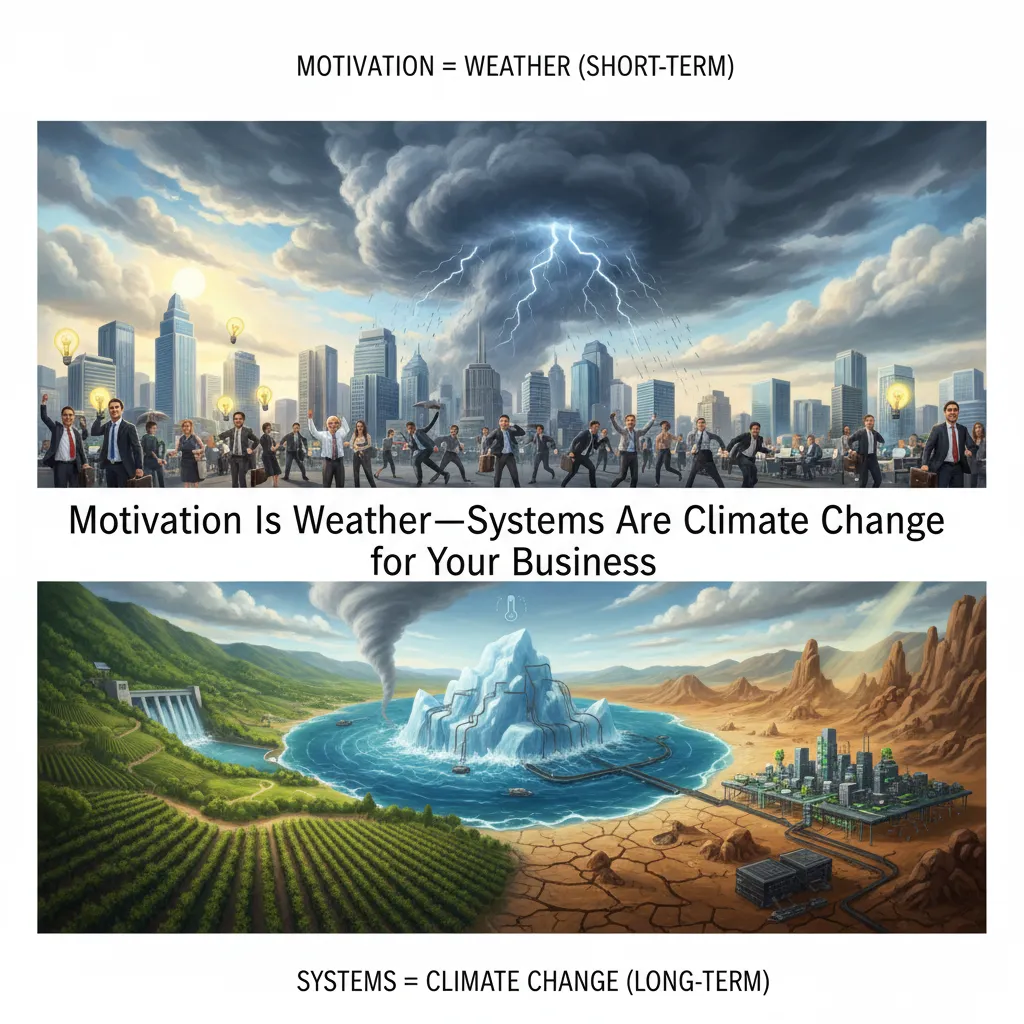One time, I nearly missed the sunrise—because I was waiting for a jolt of motivation to get moving. But back in the service, nobody handed out inspiration before roll call. That experience stuck: discipline outruns motivation every single day. In business, the same is true—systems make sure you show up, rain or shine, and keep your team engaged long after novelty fades. Let’s get honest about what it really takes to build momentum that compounds.
Motivation Is Weather—Systems Are Climate Change for Your Business
Let’s get real: motivation is as unpredictable as the weather in Texas. One day you’re fired up and ready to conquer the world; the next, you’re stuck in a fog of procrastination. I’ve lived it—crushing it on Monday, then staring at my to-do list on Tuesday, wondering where all that drive went. That’s why I say: stop waiting for motivation. Build routines and systems that keep your business moving, rain or shine.
‘You do not rise to the level of your goals. You fall to the level of your systems.’ – James Clear
Motivation Changes Fast—Systems Provide Steadiness
Think of motivation as a weather pattern—bright and sunny at 8:00 AM, hailstorm by 9:00. If you rely on “feeling motivated,” your business will be as unpredictable as the forecast. Systems are your climate change: they create the long-term environment for success. In the military, nobody asked if you felt like showing up. You showed up because the system demanded it. That’s the same discipline your business needs.
Employee Motivation Strategies: Routines Over Moods
The best Employee Motivation Strategies don’t depend on hype or mood swings. They’re built on routines—posting schedules, content pipelines, and a consistent KPI rhythm. These systems outlast any burst of inspiration. If you want to keep motivating employees and drive business team motivation, make routines non-negotiable.
- Daily (30–45 min): Check leads → Post 1 short-form → Reply to 5 comments → Track 1 KPI (subs, CTR, RPM).
- Mon/Wed/Fri: Draft 1 long-form asset (blog or YouTube), repurpose to Shorts & social.
- Tue/Thu: Funnel + email ops: test opt-in, write 1 email, fix 1 page, review analytics.
- Sun: After Action Review (AAR): what worked, what sucked, what to fix.
SMART Goals: Appointments With Yourself
One of the most effective motivational techniques is setting SMART Goals—Specific, Measurable, Achievable, Relevant, and Time-bound. These aren’t just chores; they’re appointments with yourself and your team. SMART Goals give you clear, attainable targets for each day and week, making it easier to stay on track even when motivation dips.
Systems Work for Teams—Not Just Solo Operators
Whether you’re a solo founder or leading a team, systems help everyone stay aligned. Motivating employees becomes easier when everyone knows the routine and what’s expected. When your team has a repeatable weekly battle plan, you don’t have to rely on pep talks or hope that everyone “feels it” today. The routine does the heavy lifting.
Here’s the truth: the “boring” reps—one blog, one Short, one email—compound into traffic, trust, and sales. The enemy isn’t the algorithm; it’s inconsistency. Build your climate, not just your weather.

Designing Routines You Can Actually Win (No More Superhero Syndrome)
If you’ve ever tried to copy a “5 AM Miracle Morning” or the latest hustle influencer’s 12-step routine, you know how quickly reality smacks you down. I’ve been there. One week, I tried mirroring a mega-productive YouTuber’s schedule—waking up at dawn, batching content, meditating, cold showers, the works. By Wednesday, I was exhausted, behind on actual work, and my motivation had tanked. That’s when I realized: routines only work if they fit your life, not someone else’s highlight reel.
Build Routines That Fit Your Reality
Forget superhero syndrome. The real win is designing daily flows you can actually stick to. The military taught me this: nobody waits for motivation to show up. You follow the system, and the system delivers results. In business, that means building routines that are simple, repeatable, and rooted in Intrinsic Motivation—the satisfaction of seeing daily progress and small wins.
- Daily (30–45 min): Check leads → Post 1 short-form → Reply to 5 comments → Track 1 KPI (subs, CTR, RPM).
- Mon/Wed/Fri: Draft 1 long-form asset (blog, video), then repurpose to Shorts or social.
- Tue/Thu: Funnel and email ops—test opt-ins, write 1 email, fix 1 page, review analytics.
- Sun: After Action Review (AAR): what worked, what sucked, what to fix.
This structure isn’t about grinding 18 hours a day. It’s about Work-life Balance—making sure your routine is sustainable, not soul-crushing. When you see regular, attainable progress, Employee Engagement skyrockets. Teams thrive on immediate praise and recognition, so celebrate those daily wins. A quick Slack shoutout or a “nice work” in the group chat goes a long way.
Set Attainable, SMART Goals
Don’t obsess over perfection. Instead, focus on SMART Goals—Specific, Measurable, Achievable, Relevant, and Time-bound. For example: “Post 1 short-form video before 10 AM” is clear and doable. Over time, these small disciplines compound into big results.
‘Small disciplines repeated with consistency every day lead to great achievements gained slowly over time.’ – John Maxwell
Make AI Your Routine Enforcer
AI tools can help enforce your routines. Use them to draft outlines, schedule posts, spin up new content ideas, or even summarize comments for tomorrow’s tasks. The less you rely on fleeting motivation, the more you can trust your systems to keep you moving forward.
Remember: the enemy isn’t the algorithm—it’s inconsistency. The “boring” reps—one blog, one Short, one email—are what build traffic, trust, and sales. When you design routines you can actually win, you create a climate of progress, not just a weather pattern of motivation.

Let AI Be Your Drill Sergeant (But You Stay the General)
Here’s the truth: AI in business is the ultimate routine enforcer. It’s the drill sergeant who never gets tired, never forgets, and never lets things slip through the cracks. But remember, you’re still the general. You set the vision, the business goals, and the priorities—AI just makes sure the troops (your tasks) show up for duty, every single day.
Simplify Content Creation—All on Autopilot
Let’s talk about the daily grind. Outlines, captions, scheduling, repurposing—these are the repetitive reps that build your brand, but they can suck up hours. With AI, you can:
- Draft blog outlines, scripts, and captions in minutes, not hours.
- Schedule posts across all your platforms with a few clicks.
- Repurpose content—turn one blog into a week’s worth of Shorts, emails, and social posts.
This isn’t just about saving time. It’s about reducing context-switching so you can focus on high-level strategy and creative work. The more you automate, the more you can lead.
Spin One Topic Into Ten—No More Headline Writer’s Block
Ever stare at a blank page, waiting for inspiration to strike? AI tools can take a single topic and instantly generate:
- 10+ fresh content angles (pain points, myths, step-by-step guides, case studies, checklists)
- Headline options and hooks that actually convert
- Social captions tailored for each platform
Suddenly, “I don’t know what to post” isn’t an excuse. AI keeps your content pipeline full, which is a game-changer for performance improvement and hitting your business goals.
AI Chat and Assistants: Your 24/7 Operations Team
AI isn’t just for content. Modern employee incentive programs and business routines now include AI-powered assistants that:
- Handle FAQs and customer support via chat widgets
- Summarize comments and feedback so you know what’s resonating
- Pull trending topics and prep tomorrow’s task list
- Analyze data for your weekly After Action Review (AAR)
Imagine waking up to a dashboard that tells you exactly what to fix, what’s working, and what to double down on. That’s performance improvement on autopilot.
Automation = More Life
Here’s a quick story: The first time I let AI schedule my content for the week, I took my kid to the park instead of staring at a screen. The posts went live, the comments rolled in, and my business didn’t miss a beat. That’s the real power of automation—more life, less burnout.
‘AI won’t replace you, but someone using AI just might.’ – Brian Solis
Leverage AI as your drill sergeant. Let it enforce your systems, keep your routines battle-ready, and free you up to lead. That’s how you win the war on inconsistency—and build a business that actually grows.

SOPs: The Playbooks That Make Consistency a Habit (and Not a Headache)
Let’s get real: motivation is fickle, but Standard Operating Procedures (SOPs) are the backbone of any business that wants to win—day in, day out. I learned this the hard way. When I started building routines for my business, I realized that even my best “motivated” days couldn’t beat a simple, clear SOP that anyone could follow. If you want to stop relying on willpower and start seeing real results, it’s time to treat SOPs as your playbooks for consistency.
Bulletproof Systems: Turn Recurring Tasks into SOPs
Here’s my rule: every recurring task—posting a YouTube video, sending an email, onboarding a new client—gets a written SOP. Not a novel, not a wall of text. Just 5–10 bullet points that break down the task so clearly that a total newbie could nail it. If you can’t hand your SOP to a brand-new private (or, wild card, your grandma) and get a decent result, start over. Clarity wins, every time.
- Define the goal: What’s the outcome?
- List each step: No guesswork, no skipped details.
- Add screenshots or short videos if needed.
- Test it: Can someone with zero context follow it?
- Update regularly: SOPs are living documents.
Manager-Driven Approaches: Set the Standard, Model the Standard
As a leader, your job isn’t just to create SOPs—it’s to use them and show your team how. Manager-driven approaches mean you set the bar for documentation and process. When your team sees you following SOPs, they know you’re serious about consistency and quality. This isn’t about micromanaging; it’s about building a culture where everyone knows what “good” looks like, every single time.
‘If you want it done right without you, systemize it.’ – Michael Gerber
Boost Team Engagement and Employee Retention
Clear SOPs don’t just make your life easier—they supercharge team engagement and employee retention. When people know exactly what’s expected, they feel more confident and less stressed. New hires ramp up faster, and veterans spend less time answering the same questions. SOPs create a positive work environment where everyone can focus on what matters: results.
Wild Card Test: The Grandma Upload
Here’s my favorite test: could your grandma upload a YouTube video using your SOP? If not, it’s time to simplify. The best SOPs are so clear, anyone can execute them—no matter their background or skill level. That’s how you build a business that runs smoothly, even when motivation is nowhere to be found.
Remember, the boring reps—the ones you can hand off—are the ones that compound into growth. SOPs are your secret weapon for making consistency a habit, not a headache.
The Boring Stuff Wins—Watch Compounding Pay Out
Let’s get real: the secret sauce to Performance Improvement and Business Team Motivation isn’t some wild, once-in-a-lifetime breakthrough. It’s the boring stuff—the daily, unsexy reps that most people overlook or abandon. I’ve seen it firsthand, both in the military and in business. The people who win aren’t the ones chasing fireworks; they’re the ones who show up, rain or shine, and do the work. That’s the backbone of every effective Employee Motivation Strategy I’ve ever used or seen.
Here’s the truth: most people quit because they expect every day to feel exciting. They want motivation to hit like a lightning bolt. But business, like fitness or military training, is built on small, steady actions. One blog post. One email. One comment reply. These simple, repeatable actions compound over time into trust, audience, and revenue. As James Clear put it,
‘Success is the product of daily habits—not once-in-a-lifetime transformations.’
Let me give you a quick story. There was a month where I absolutely hated updating my content spreadsheet. It felt tedious and pointless—just another box to check. But when I finally reviewed the numbers, I realized that those “boring” entries had quietly paid for my vacation. The spreadsheet didn’t care if I was motivated; it just tracked the compounding results of my routine. That’s when it clicked: boring routines are why Employee Motivation Strategies actually stick. They’re the glue that holds your performance together, even when you don’t feel like showing up.
Consistent routines are the real driver of Performance Improvement and Employee Recognition. When you show up every day, even in small ways, you build a foundation of trust with your team and your audience. Over time, those small wins add up. And when you recognize your team for sticking to the routine—celebrating the “boring” wins—you reinforce the behaviors that drive long-term growth. That’s how you turn the mundane into momentum.
It’s easy to blame the algorithm or the market for slow growth. But the real enemy is inconsistency. The businesses that thrive are the ones that embrace the grind, not just the glory. They understand that Business Team Motivation isn’t about hype—it’s about building systems that make showing up automatic. The “boring” reps are what separate the pros from the amateurs.
If you want to see compounding pay out, stop waiting for motivation. Build routines that win, even when you don’t feel like it. Trust the process, celebrate the small wins, and remember: the boring stuff is where the magic happens. Follow my daily drops to copy the exact routines I use. For veterans and business builders alike, systems beat motivation—every single time.
TL;DR: Cute quotes and pep talks fade before noon. Build routines, reinforce them with systems (and a little AI sidekick), and your motivation issues will solve themselves. It’s not magic—just the discipline to keep showing up and improving, day after day.



